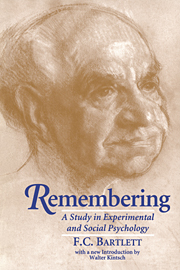Book contents
- Frontmatter
- Contents
- Biography of Sir Frederic C. Bartlett
- Introduction by Walter Kintsch
- Preface
- PART I EXPERIMENTAL STUDIES
- Chapter I Experiment in Psychology
- Chapter II Experiments on Perceiving
- Chapter III Experiments on Imaging
- Chapter IV Experiments on Remembering: (a) The Method of Description
- Chapter V Experiments on Remembering: (b) The Method of Repeated Reproduction
- Chapter VI Experiments on Remembering: (c) The Method of Picture Writing
- Chapter VII Experiments on Remembering: (d) The Method of Serial Reproduction; I
- Chapter VIII Experiments on Remembering: (e) The Method of Serial Reproduction; II. Picture Material
- Chapter IX Perceiving, Recognising, Remembering
- Chapter X A Theory of Remembering
- Chapter XI Images and their Functions
- Chapter XII Meaning
- PART II REMEMBERING AS A STUDY IN SOCIAL PSYCHOLOGY
- Index
- Plate section
Chapter XI - Images and their Functions
Published online by Cambridge University Press: 04 August 2010
- Frontmatter
- Contents
- Biography of Sir Frederic C. Bartlett
- Introduction by Walter Kintsch
- Preface
- PART I EXPERIMENTAL STUDIES
- Chapter I Experiment in Psychology
- Chapter II Experiments on Perceiving
- Chapter III Experiments on Imaging
- Chapter IV Experiments on Remembering: (a) The Method of Description
- Chapter V Experiments on Remembering: (b) The Method of Repeated Reproduction
- Chapter VI Experiments on Remembering: (c) The Method of Picture Writing
- Chapter VII Experiments on Remembering: (d) The Method of Serial Reproduction; I
- Chapter VIII Experiments on Remembering: (e) The Method of Serial Reproduction; II. Picture Material
- Chapter IX Perceiving, Recognising, Remembering
- Chapter X A Theory of Remembering
- Chapter XI Images and their Functions
- Chapter XII Meaning
- PART II REMEMBERING AS A STUDY IN SOCIAL PSYCHOLOGY
- Index
- Plate section
Summary
SOME CHARACTERISTICS OF IMAGES
If the theory of remembering which has just been developed is justified, it is clear that images have fundamentally important parts to play in mental life. This hardly appears to be a popular view in modern psychology. It is not only the extreme behaviourist who is tempted to think that psychology can gain little advantage from a close study of images. In less radical circles also it is often held that, since images are generally vague, fleeting, and variable from person to person and from time to time, hardly any statement can be made about them which will not be immediately contradicted on very good authority. This view has arisen because most statements that have been made about images in traditional psychology concern their nature rather than their functions, what they are rather than what they make it possible to do; and many of the controversies that have raged about them have been concerned primarily with their epistemological status. Undoubtedly considerations about the nature of imagery, and its relation, on the one hand to a world of external objects, and on the other to immediate sensory perception, raise important, interesting and singularly intractable problems. It is not these with which we are now concerned, but simply with the question of what, exactly, images have to do in the general growth of mental life.
- Type
- Chapter
- Information
- RememberingA Study in Experimental and Social Psychology, pp. 215 - 226Publisher: Cambridge University PressPrint publication year: 1995



